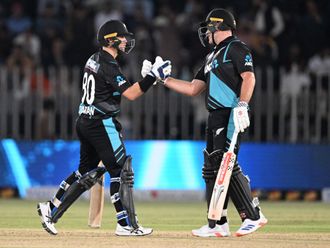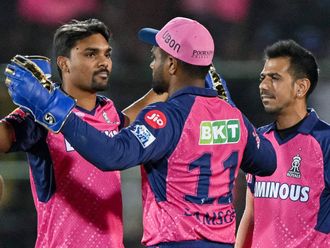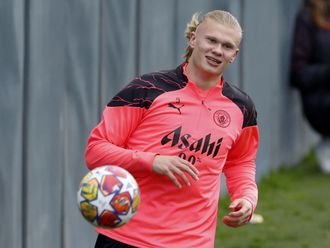London: Mostly, it felt like the end of something.
The autumnal chill in the air. The eclectically left-field selections on either side. The distinctly “school’s-out” feel to the denouement, most evident in the industrial-sized snakes made from plastic cups and Mexican waves being assembled in the temporary stand.
This has been a long and incomparably strange summer; one entirely devoid of narrative thread, which is perhaps inevitable when two teams play so often they exhaust all possible narratives. Sort of a monkeys-and-typewriters scenario in reverse: pit an infinite number of Englands against an infinite number of Australias, and eventually they will manage to lose to each other in every grotesque and surreal manner imaginable.
But peer closely enough at the wreckage of England’s defeat here, indeed this entire unloved appendage of a one-day series, and perhaps you could spot the beginning of something, too.
I have in front of me an old copy of The Cricketer magazine from 1994, an impulse purchase from the Derbyshire club shop earlier this summer. Headlined “Aussie Paper Tigers”, it documents the crisis in Australia’s fast-bowling ranks ahead of the series against England. Former Test player Mike Whitney laments the dearth of quality pacemen to take over from the likes of Craig McDermott and Merv Hughes, and points out that the future of the Australian attack rests almost entirely with a “very experienced” fast-medium bowler by the name of Glenn McGrath. These were real and quite founded fears.
Built on pace
Since the Second World War, from Ray Lindwall and Keith Miller to Dennis Lillee and Jeff Thomson, Australian attacks had almost entirely been built on pace. Now, McGrath aside, the cupboard was bare. So the Australian Cricket Board turned to Lillee, whose pace academy in Madras had already begun to bear fruit.
Initially, Lillee was alarmed by what he discovered. Across the board, there was an acute lack of fast-bowling nous: not just technical ability, but strategy and thought. Lillee began touring Shield cricket with his Speed Australia coaching clinic, and slowly the trickle of fast bowlers thickened to a gush.
It is often overlooked how heavily Australia relied on McGrath and Shane Warne during those subsequent years: between 1995 and 2000, they took more wickets than all of Australia’s other specialist bowlers put together. Only with the emergence of Jason Gillespie and Brett Lee were they able to make the leap from very good to great.
The next generation — Mitchell Johnson, Ryan Harris, Peter Siddle — fired Australia to one of the most spectacular Ashes trouncings in history. Now, a new vanguard is emerging that should, ominously, be reaching its peak in about 2017-18. By far the biggest disparity has been between the speed and quality of the two pace attacks.
Marked difference
The difference was even more marked here, with England resting Steven Finn, Liam Plunkett and Chris Woakes, and Australia returning the new ball to the hands of Mitchell Starc. While David Willey and debutant Reece Topley wheeled away at around 80mph, Starc catapulted in at his usual 90mph lick, and struck the two decisive blows of the match.
In his first over, Jason Roy was lbw to a swinging yorker; in his fourth, England captain Eoin Morgan was smacked on the skull and led from the field in a daze. Now, you could quibble about Roy’s lbw decision (wrong) or Morgan’s injury (unfortunate). You could point out that Starc actually bowled quite modestly thereafter and that England were actually undone by the gentler rhythms of John Hastings and Mitchell Marsh, who shared seven wickets between them.
But over the whole series, Australia’s heavier artillery has told. The scintillating, terrifying Pat Cummins has been the leading wicket-taker in the series with 12; England’s two leading bowlers have been spinners. Now take Starc (25 years old), Cummins (22), Nathan Coulter-Nile (27) and James Pattinson (25). Add Sean Abbott (23), Gurinder Sandhu (22) and Josh Hazlewood (24), and give them a couple of years’ sanding and seasoning.
Now put them on helpful surfaces in front of a bloodthirsty home crowd. Suddenly, England’s Ashes defence looks far less pleasant. These were two remarkably young teams in Manchester: of the 22 players, only one (George Bailey) was older than 30. And while the Ashes may have only just been prised from Australia’s grasp, we may just have caught a glimpse of how they intend to win them back.
— The Telegraph Group Limited, London 2015












